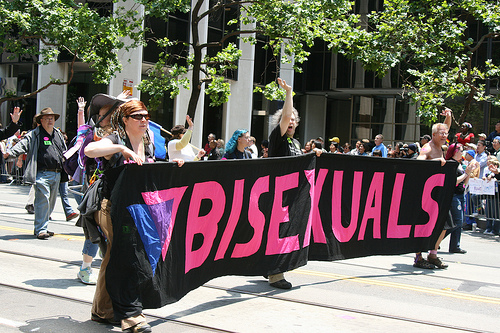 In “Bisexuality in an Essentialist World: Toward an Understanding of Biphobia” (it appears in Bisexuality: A Reader and Sourcebook; unfortunately I don’t have a direct link to the text)- one of the more personally challenging essays in my sociology of sex course- Amanda Udis-Kessler challenges us to rethink our sexual dichotomies. It reminded me of Alan, and it reminded me of LUGs.
In “Bisexuality in an Essentialist World: Toward an Understanding of Biphobia” (it appears in Bisexuality: A Reader and Sourcebook; unfortunately I don’t have a direct link to the text)- one of the more personally challenging essays in my sociology of sex course- Amanda Udis-Kessler challenges us to rethink our sexual dichotomies. It reminded me of Alan, and it reminded me of LUGs.
And it changed my mind about both.
The concept of people being on a spectrum of sexuality didn’t bother me. The changeability, however, did. And it’s bothered me for a long time.
Alan was a friend while I was in college. He was somewhat effeminate in nature – moreso than the openly gay friend I had – but had a girlfriend who was, as the kids say today, hawt. But because of his effeminate nature, he routinely was teased about his sexuality. Less than a year after I left town, I heard that he had “decided that since everyone was teasing him about being gay, he might as well be gay,” and was happy since. I figured this to be so much bullshit, and a capitulation of will under social pressure.
Recently I heard about the “LUGs” phenomenon – Lesbian Until Graduation. It didn’t matter why the sexual status changed, just the mere fact of its changing was a signal that they weren’t serious. Again, perhaps it was kowtowing to social pressures (though heteronormative ones), or graduation signaling an end to an experimental phase. Regardless, they weren’t “really” gay. Just bisexual.
“Just”. Hm.
The conflation of conscious choice and change is a dangerous one, and even though this essay challenges exactly that, I still find it difficult to keep them separate in my mind. I didn’t choose to be heterosexual, and the gay friends I’ve known have unanimously reported “just knowing” that they were gay.
And this suggests that it’s not as easy as all that.
Over time, my taste in women has changed – quite a bit. We don’t think anything about that kind of dramatic transition – but if it happens to cross a gender line, then we somehow think that it’s qualitatively different. I don’t think I can buy that anymore.
I do feel that the analysis of heteronormist attacks is overly naive and trusting; while separating change in behavior and choice might seem natural to one who is used to constructionist tendencies, it is difficult for the average person. (Or in other words – we shouldn’t be bothering to argue whether sexual orientation is inborn, we should instead be arguing that it’s not for others to dictate to you.)
It is difficult to separate out these actions from the labels. The social consequences of divorcing ourselves from easily categorizable groups is a higher degree of chaos and confusion (“Hi, I think you’re hot… oh, are you not responding because you’re into guys this week, or is it me?”) that our society simply doesn’t have the tools or tolerance to deal with yet.
There are two people in the world – those who categorize people into groups, and those who don’t. Discuss.

Surprisingly, the people I’ve known who’ve had the most trouble with the notion of bisexuality are the gay people. That’s not to say that I don’t know straights who have the same problem, it just seems more prevalent. Of course, this is just my personal observation of my own friends and acquaintances and not based on any actual data, so I wouldn’t presume to suggest that this is true for everyone.
I think that what bothers the people I know is that notion of “choosing” or “not being serious”. I personally don’t have a problem with someone being attracted to individuals of either gender.